解説:池田光穂
★ホモ・エルガスターは、前期更新世 にアフリカに生 息していた古人類の絶滅種または亜種である。エルガスターが独自の種を構成しているのか、それともホモ・エレクトスに包含されるべきなのかは、古人類学の 中で現在も続いている未解決の論争である。同義語の支持者は通常、H. ergasterを「アフリカのホモ・エレクトス」[2]または「ホモ・エレクトス・エルガスター」と呼んでいる[3]。ホモ・エルガスターという名前 は、彼らの祖先のものと比べてより高度な道具を使用する種であることを意味する「働く男」に大まかに翻訳される。ホモ・エルガスターの化石は、主に170 万年前から140万年前までの期間をカバーしているが、より広い範囲の化石が発見されている可能性もある。アフリカには100万年前より若い化石もあり、 長期的な解剖学的連続性を示しているが、正式にエルガスターの標本とみなすことができるかどうかは不明である。年代種としては、エルガスターはアフリカで ホモの新系統が誕生した60万年前まで存続していた可能性がある。
| 人の進化(human evolution) |
|
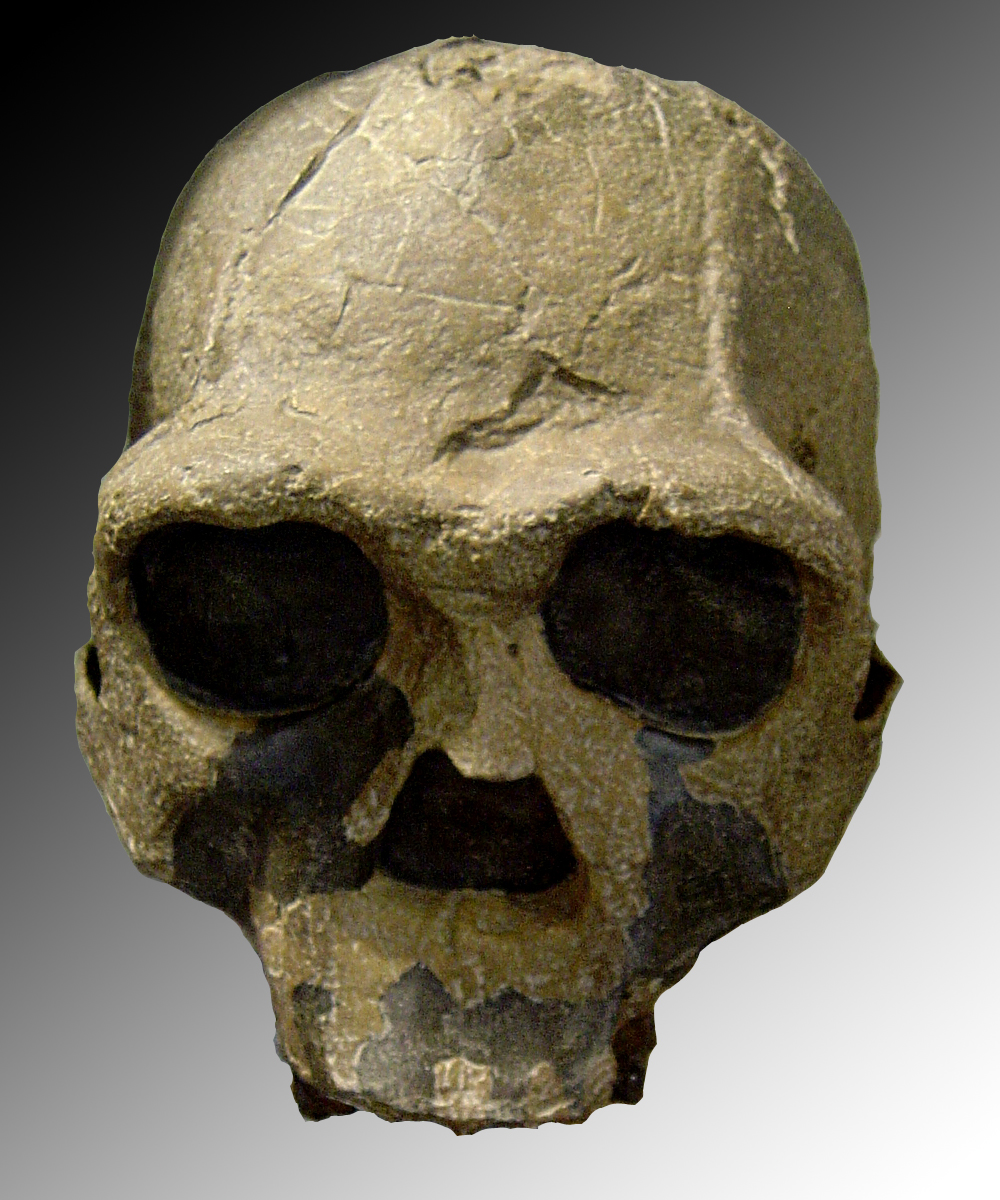 Homo ergaster
is an extinct species or subspecies of archaic humans who lived in
Africa in the Early Pleistocene. Whether H. ergaster constitutes a
species of its own or should be subsumed into H. erectus is an ongoing
and unresolved dispute within palaeoanthropology. Proponents of
synonymisation typically designate H. ergaster as "African Homo
erectus"[2] or "Homo erectus ergaster".[3] The name Homo ergaster
roughly translates to "working man", a reference to the more advanced
tools used by the species in comparison to those of their ancestors.
The fossil range of H. ergaster mainly covers the period of 1.7 to 1.4
million years ago, though a broader time range is possible.[4] Though
fossils are known from across East and Southern Africa, most H.
ergaster fossils have been found along the shores of Lake Turkana in
Kenya. There are later African fossils, some younger than 1 million
years ago, that indicate long-term anatomical continuity, though it is
unclear if they can be formally regarded as H. ergaster specimens. As a
chronospecies, H. ergaster may have persisted to as late as 600,000
years ago, when new lineages of Homo arose in Africa. Homo ergaster
is an extinct species or subspecies of archaic humans who lived in
Africa in the Early Pleistocene. Whether H. ergaster constitutes a
species of its own or should be subsumed into H. erectus is an ongoing
and unresolved dispute within palaeoanthropology. Proponents of
synonymisation typically designate H. ergaster as "African Homo
erectus"[2] or "Homo erectus ergaster".[3] The name Homo ergaster
roughly translates to "working man", a reference to the more advanced
tools used by the species in comparison to those of their ancestors.
The fossil range of H. ergaster mainly covers the period of 1.7 to 1.4
million years ago, though a broader time range is possible.[4] Though
fossils are known from across East and Southern Africa, most H.
ergaster fossils have been found along the shores of Lake Turkana in
Kenya. There are later African fossils, some younger than 1 million
years ago, that indicate long-term anatomical continuity, though it is
unclear if they can be formally regarded as H. ergaster specimens. As a
chronospecies, H. ergaster may have persisted to as late as 600,000
years ago, when new lineages of Homo arose in Africa.Those who believe H. ergaster should be subsumed into H. erectus consider there to be too little difference between the two to separate them into distinct species. Proponents of keeping the two species as distinct cite morphological differences between the African fossils and H. erectus fossils from Asia, as well as early Homo evolution being more complex than what is implied by subsuming species such as H. ergaster into H. erectus. Additionally, morphological differences between the specimens commonly seen as constituting H. ergaster might suggest that H. ergaster itself does not represent a cohesive species. Regardless of their most correct classification, H. ergaster exhibit primitive versions of traits later expressed in H. erectus and are thus likely the direct ancestors of later H. erectus populations in Asia. Additionally, H. ergaster is likely ancestral to later hominins in Europe and Africa, such as modern humans and Neanderthals. Several features distinguish H. ergaster from australopithecines as well as earlier and more basal species of Homo, such as H. habilis. Among these features are their larger body mass, relatively long legs, obligate bipedalism, relatively small jaws and teeth (indicating a major change in diet) as well as body proportions and inferred lifestyles more similar to modern humans than to earlier and contemporary hominins. With these features in mind, some researchers view H. ergaster as being the earliest true representative of the genus Homo. H. ergaster lived on the savannah in Africa, a unique environment with challenges that would have resulted in the need for many new and distinct behaviours. Earlier Homo probably used counter-attack tactics, like modern primates, to keep predators away. By the time of H. ergaster, this behaviour had probably resulted in the development of true hunter-gatherer behaviour, a first among primates. H. ergaster was an apex predator.[5] Further behaviours that might first have arisen in H. ergaster include male-female divisions of foraging and true monogamous pair bonds. H. ergaster also marks the appearance of more advanced tools of the Acheulean industry, including the earliest known hand axes. Though undisputed evidence is missing, H. ergaster might also have been the earliest hominin to master control of fire. |
 ホモ・エ
ルガスターは、前期更新世にアフリカに生息していた古人類の絶滅種または亜種である。エルガスターが独自の種を構成しているのか、それともホモ・
エレクトスに包含されるべきなのかは、古人類学の中で現在も続いている未解決の論争である。同義語の支持者は通常、H.
ergasterを「アフリカのホモ・エレクトス」[2]または「ホモ・エレクトス・エルガスター」と呼んでいる[3]。ホモ・エルガスターという名前
は、彼らの祖先のものと比べてより高度な道具を使用する種であることを意味する「働く男」に大まかに翻訳される。ホモ・エルガスターの化石は、主に170
万年前から140万年前までの期間をカバーしているが、より広い範囲の化石が発見されている可能性もある。アフリカには100万年前より若い化石もあり、
長期的な解剖学的連続性を示しているが、正式にエルガスターの標本とみなすことができるかどうかは不明である。年代種としては、エルガスターはアフリカで
ホモの新系統が誕生した60万年前まで存続していた可能性がある。 ホモ・エ
ルガスターは、前期更新世にアフリカに生息していた古人類の絶滅種または亜種である。エルガスターが独自の種を構成しているのか、それともホモ・
エレクトスに包含されるべきなのかは、古人類学の中で現在も続いている未解決の論争である。同義語の支持者は通常、H.
ergasterを「アフリカのホモ・エレクトス」[2]または「ホモ・エレクトス・エルガスター」と呼んでいる[3]。ホモ・エルガスターという名前
は、彼らの祖先のものと比べてより高度な道具を使用する種であることを意味する「働く男」に大まかに翻訳される。ホモ・エルガスターの化石は、主に170
万年前から140万年前までの期間をカバーしているが、より広い範囲の化石が発見されている可能性もある。アフリカには100万年前より若い化石もあり、
長期的な解剖学的連続性を示しているが、正式にエルガスターの標本とみなすことができるかどうかは不明である。年代種としては、エルガスターはアフリカで
ホモの新系統が誕生した60万年前まで存続していた可能性がある。エルガスター種をエレクタス種に含めるべきだと考える人々は、両種を別個の種に分けるには、両者の間にあまりに違いがなさすぎると考えている。2つの種を 別個のものとして維持する賛成派は、アフリカの化石とアジアで産出したH.エレクタスの化石との間の形態学的な違いや、初期のホモの進化がH.エルガス ターのような種をH.エレクタスに包含することで暗示されるよりも複雑であったことを挙げている。さらに、エルガスターを構成する種と一般に考えられてい る標本間の形態学的相違は、エルガスター自体がまとまった種ではないことを示唆しているのかもしれない。最も正しい分類にかかわらず、エルガスターは後に H. erectusに発現する形質の原始版を示しており、したがってアジアにおける後のH. erectus個体群の直接の祖先である可能性が高い。さらにエルガスターは、ヨーロッパとアフリカの現生人類やネアンデルタール人など、後のホミニンの 祖先である可能性が高い。 エルガスターは、アウストラロピテクスや、ハビリスなど、より古く、より基底的なホモの一種と区別される特徴がいくつかある。これらの特徴の中には、体格 の大きさ、比較的長い脚、義務的な二足歩行、比較的小さな顎と歯(食生活が大きく変化したことを示す)、さらに体のプロポーションや推測される生活様式 が、それ以前のホモや現代のホモよりも現代人に近いことなどがある。これらの特徴を考慮し、エルガスターをホモ属最古の真の代表とみなす研究者もいる。 エルガスターはアフリカのサバンナで生活していたが、このような特殊な環境では、多くの新しく独特な行動が必要であっただろう。それ以前のホモはおそら く、現代の霊長類と同じように、捕食者を遠ざけるために反撃の戦術を使っていたのだろう。エルガスターの時代には、この行動はおそらく霊長類では初とな る、真の狩猟採集行動を発達させた。H. ergasterは頂点捕食者であった[5]。H. ergasterで初めて生じたと思われる行動には、オスとメスによる採食の分担や、真の一夫一婦制のペア結合などがある。H. ergasterはまた、最古の手斧を含む、より高度なアシュレアン産業の道具の出現を示す。議論の余地のない証拠は見つかっていないが、エルガスターは 火を操ることができる最古のヒト科動物であった可能性もある。 |
Research history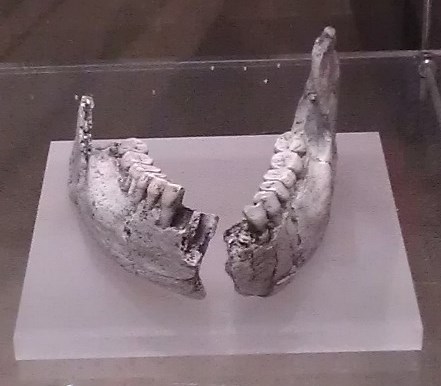 Replica of KNM ER 992, the holotype specimen of Homo ergaster The systematics and taxonomy of Homo in the Early to Middle Pleistocene is one of the most disputed areas of palaeoanthropology.[6] In early palaeoanthropology and well into the twentieth century, it was generally assumed that Homo sapiens was the end result of gradual modifications within a single lineage of hominin evolution. As the perceived transitional form between early hominins and modern humans, H. erectus, originally assigned to contain archaic human fossils in Asia, came to encompass a wide range of fossils covering a large span of time (almost the entire temporal range of Homo). Since the late twentieth century, the diversity within H. erectus has led some to question what exactly defines the species and what it should encompass. Some researchers, such as palaeoanthropologist Ian Tattersall in 2013, have questioned H. erectus since it contains an "unwieldly" number of fossils with "substantially differing morphologies".[7] In the 1970s, palaeoanthropologists Richard Leakey and Alan Walker described a series of hominin fossils from Kenyan fossil localities on the eastern shore of Lake Turkana. The most notable finds were two partial skulls; KNM ER 3733 and KNM ER 3883, found at Koobi Fora. Leakey and Walker assigned these skulls to H. erectus, noting that their brain volumes (848 and 803 cc respectively) compared well to the far younger type specimen of H. erectus (950 cc). Another significant fossil was a fossil mandible recovered at Ileret and described by Leakey with the designation KNM ER 992 in 1972 as "Homo of indeterminate species".[8] In 1975, palaeoanthropologists Colin Groves and Vratislav Mazák designated KNM ER 992 as the holotype specimen of a distinct species, which they dubbed Homo ergaster.[9] The name (ergaster being derived from the Ancient Greek ἐργαστήρ, ergastḗr, 'workman') roughly translates to "working man"[10] or "workman".[11] Groves and Mazák also included many of the Koobi Fora fossils, such as KNM ER 803 (a partial skeleton and some isolated teeth) in their designation of the species, but did not provide any comparison with the Asian fossil record of H. erectus in their diagnosis, inadvertently causing some of the later taxonomic confusion in regards to the species.[12] A nearly complete fossil, interpreted as a young male (though the sex is actually undetermined), was discovered at the western shore of Lake Turkana in 1984 by Kenyan archaeologist Kamoya Kimeu.[11] The fossils were described by Leakey and Walker, alongside paleoanthropologists Frank Brown and John Harris, in 1985 as KNM-WT 15000 (nicknamed "Turkana Boy"). They interpreted the fossil, consisting of a nearly complete skeleton, as representing H. erectus.[13] Turkana Boy was the first discovered comprehensively preserved specimen of H. ergaster/erectus found and constitutes an important fossil in establishing the differences and similarities between early Homo and modern humans.[14] Turkana Boy was placed in H. ergaster by paleoanthropologist Bernard Wood in 1992,[11] and is today, alongside other fossils in Africa previously designated as H. erectus, commonly seen as a representative of H. ergaster by those who support H. ergaster as a distinct species.[15 |
研究の歴史 ホモ・エルガスターのホロタイプ標本KNM ER 992のレプリカ 前期更新世から中期更新世におけるホモの系統と分類学は、古人類学で最も論争が多い分野の一つである[6]。初期の古人類学から20世紀まで、ホモ・サピ エンスはヒトの進化の単一系統の中で徐々に変化した最終結果であると一般的に考えられていた。初期ホミニンと現生人類の過渡的な形態として認識されていた H.エレクタスは、当初アジアの古代のヒトの化石を含むとされていたが、大きなスパン(ホモのほぼ全時間的範囲)をカバーする幅広い化石を包含するように なった。20世紀後半以降、H. erectusの多様性から、種を定義するものは一体何なのか、何を包含すべきなのか、という疑問の声が上がっている。2013年の古人類学者イアン・ タッターソールのように、H. erectusには「実質的に異なる形態」を持つ「扱いにくい」数の化石が含まれていることから、H. erectusに疑問を呈する研究者もいる[7]。 1970年代、古人類学者のリチャード・リーキーとアラン・ウォーカーは、トゥルカナ湖の東岸にあるケニアの化石産地で発見された一連のヒト科の化石につ いて記述した。最も注目すべき発見は、Koobi Foraで発見されたKNM ER 3733とKNM ER 3883の2つの部分頭骨である。LeakeyとWalkerは、これらの頭蓋骨の脳容積(それぞれ848ccと803cc)が、H. erectusの遥かに若いタイプ標本(950cc)とよく比較されていることに注目し、H. erectusと断定した。もう一つの重要な化石は、イレレで発見された下顎骨の化石であり、1972年にリーキーによってKNM ER 992という名称で「種不詳のホモ」として記載された[8]。 1975年、古人類学者のコリン・グローブスとブラチスラフ・マザークは、KNM ER 992を別種のホロタイプ標本とし、ホモ・エルガスターと命名した[9]。この名前(エルガスターは古代ギリシャ語のἐργαστήρ, ergastė, 'workman'に由来する)は、大まかに訳すと「働く人」[10]または「労働者」となる。 [11] グローブスとマザークはまた、KNM ER 803(部分骨格といくつかの孤立した歯)のようなコオビ・フォラの化石の多くをこの種の呼称に含めたが、その診断においてH. erectusのアジアの化石記録との比較を示さなかったため、不注意にもこの種に関する後の分類学的混乱の原因となった[12]。 1984年にケニアの考古学者であるカモヤ・キメウによってトゥルカナ湖の西岸で若い男性(実際には性別は未確定)と解釈されるほぼ完全な化石が発見され た[11]。彼らは、ほぼ完全な骨格からなるこの化石をエルガスター・エレクトス(H. erectus)と解釈した[13]。トゥルカナ・ボーイは、エルガスター・エレクトスの完全な保存状態で発見された最初の標本であり、初期ホモと現生人 類の相違点と類似点を明らかにする上で重要な化石である。 [14]トゥルカナ・ボーイは1992年に古人類学者のバーナード・ウッドによってエルガスターに分類され[11]、現在ではエルガスターを別種として支 持する人々によって、以前はエルガスターとして指定されていたアフリカの他の化石と並んで、エルガスターの代表として一般的に見られている[15]。 |
| Classification H. ergaster is easily distinguished from earlier and more basal species of Homo, notably H. habilis and H. rudolfensis, by a number of features that align them, and their inferred lifestyle, more closely to modern humans than to earlier and contemporary hominins. As compared to their relatives, H. ergaster had body proportions more similar to later members of the genus Homo, notably relatively long legs which would have made them obligately bipedal. The teeth and jaws of H. ergaster are also relatively smaller than those of H. habilis and H. rudolfensis, indicating a major change in diet.[16] In 1999, palaeoanthropologists Bernard Wood and Mark Collard argued that the conventional criteria for assigning species to the genus Homo were flawed and that early and basal species, such as H. habilis and H. rudolfensis, might appropriately be reclassified as ancestral australopithecines. In their view, the true earliest representative of Homo was H. ergaster.[17] Au. africanus Au. garhi H. habilis H. rudolfensis H. ergaster H. erectus H. antecessor H. heidelbergensis H. neanderthalensis H. sapiens ++++++++++++++++++ 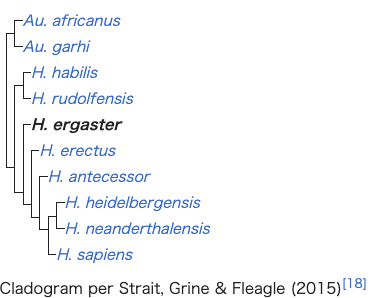 +++++++++++++++++++++++ Cladogram per Strait, Grine & Fleagle (2015)[18] Since its description as a separate species in 1975, the classification of the fossils referred to H. ergaster has been in dispute. H. ergaster was immediately dismissed by Leakey and Walker and many influential researchers, such as palaeoanthropologist G. Philip Rightmire, who wrote an extensive treatise on H. erectus in 1990, continued to prefer a more inclusive and comprehensive H. erectus. Overall, there is no doubt that the group of fossils composing H. erectus and H. ergaster represent the fossils of a more or less cohesive subset of closely related archaic humans. The question is instead whether these fossils represent a radiation of different species or the radiation of a single, highly variable and diverse, species over the course of almost two million years.[9] This long-running debate remains unresolved, with researchers typically using the terms H. erectus s.s. (sensu stricto) to refer to H. erectus fossils in Asia and the term H. erectus s.l. (sensu lato) to refer to fossils of other species that may or may not be included in H. erectus, such as H. ergaster, H. antecessor and H. heidelbergensis.[19] 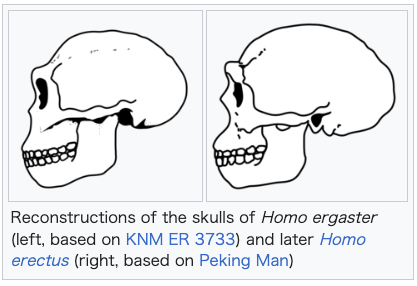 Reconstructions of the skulls of Homo ergaster (left, based on KNM ER 3733) and later Homo erectus (right, based on Peking Man) For obvious reasons, H. ergaster shares many features with H. erectus, such as large forward-projecting jaws, large brow ridges and a receding forehead.[20] Many of the features of H. ergaster are clearly more primitive versions of features later expressed in H. erectus, which somewhat obscures the differences between the two.[21] There are subtle, potentially significant, differences between the East African and East Asian fossils. Among these are the somewhat higher-domed and thinner-walled skulls of H. ergaster, and the even more massive brow ridges and faces of Asian H. erectus.[20] The question is made more difficult since it regards how much intraspecific variation can be exhibited in a single species before it needs to be split into more, a question that in and of itself does not have a clear-cut answer. A 2008 analysis by anthropologist Karen L. Baab, examining fossils of various H. erectus subspecies, and including fossils attributed to H. ergaster, found that the intraspecific variation within H. erectus was greater than expected for a single species when compared to modern humans and chimpanzees, but fell well within the variation expected for a species when compared to gorillas, and even well within the range expected for a single subspecies when compared to orangutans (though this is partly due to the great sexual dimorphism exhibited in gorillas and orangutans).[22] Baab concluded that H. erectus s.l. was either a single but variable species, several subspecies divided by time and geography or several geographically dispersed but closely related species.[23] In 2015, paleoanthropologists David Strait, Frederick Grine and John Fleagle listed H. ergaster as one of the seven "widely recognized" species of Homo, alongside H. habilis, H. rudolfensis, H. erectus, H. heidelbergensis, H. neanderthalensis and H. sapiens, noting that other species, such as H. floresiensis and H. antecessor, were less widely recognised or more poorly known.[18] Variation in the fossil material  KNM ER 3733 KNM ER 3883 KNM-WT 15000 ("Turkana Boy") Comparing various African fossils attributed to H. erectus or H. ergaster to Asian fossils, notably the type specimen of H. erectus, in 2013, Ian Tattersall concluded that referring to the African material as H. ergaster rather than "African H. erectus" was a "considerable improvement" as there were many autapomorphies distinguishing the material of the two continents from one another.[24] Tattersall believes it to be appropriate to use the designation H. erectus only for eastern Asian fossils, disregarding its previous use as the name for an adaptive grade of human fossils from throughout Africa and Eurasia. Though Tattersall concluded that the H. ergaster material represents the fossils of a single clade of Homo, he also found there to be considerable diversity within this clade; the KNM ER 992 mandible accorded well with other fossil mandibles from the region, such as OH 22 from Olduvai and KNM ER 3724 from Koobi Fora, but did not necessarily match with cranial material, such as KNM ER 3733 and KNM ER 3883 (since neither preserves the jaw), nor with the mandible preserved in Turkana Boy, which has markedly different dentition.[24] The most "iconic" fossil of H. ergaster is the KNM ER 3733 skull, which is sharply distinguished from Asian H. erectus by a number of characteristics, including that the brow ridges project forward as well as upward and arc separately over each orbit and the braincase being quite tall compared to its width, with its side walls curving. KNM ER 3733 can be distinguished from KNM ER 3883 by a number of features as well, notably in that the margins of KNM ER 3883's brow ridges are very thickened and protrude outwards but slightly downwards rather than upwards.[25] Both skulls can be distinguished from the skull of Turkana Boy, which possesses only slightly substantial thickenings of the superior orbital margins, lacking the more vertical thickening of KNM ER 3883 and the aggressive protrusion of KNM ER 3733. In addition to this, the facial structure of Turkana Boy is narrower and longer than that of the other skulls, with a higher nasal aperture and likely a flatter profile of the upper face. It is possible that these differences can be accounted for through Turkana Boy being a subadult, 7 to 12 years old.[26] Furthermore, KNM ER 3733 is presumed to have been the skull of a female (whereas Turkana Boy is traditionally interpreted as male), which means that sexual dimorphism may account for some of the differences.[14] The differences between Turkana Boy's skull and KNM ER 3733 and KNM ER 3883, as well as the differences in dentition between Turkana Boy and KNM ER 992 have been interpreted by some, such as paleoanthropologist Jeffrey H. Schwartz, as suggesting that Turkana Boy and the rest of the H. ergaster material does not represent the same taxon. Schwartz also noted none of the fossils seemed to represent H. erectus either, which he believed was in need of significant revision.[27] In 2000, French palaeoanthropologist Valéry Zeitoun suggested that KNM ER 3733 and KNM ER 3883 should be referred to two separate species, which she dubbed H. kenyaensis (type specimen KNM ER 3733) and H. okotensis (type specimen KNM ER 3883), but these designations have found little acceptance.[28] |
分類 H.エルガスターは、ホモ属の中でも特にハビリスやルドルフェンシスに代表される、より古くより基本的な種と容易に区別できる。それは、彼らや彼らの推定 される生活様式を、より古くより現代のホミニンよりも現生人類に近づける多くの特徴を持っているからである。エルガスターは、その近縁種と比較すると、体 のプロポーションが後のホモ属に似ており、特に脚が比較的長かったため、二足歩行が必須であったと思われる。1999年、古人類学者のバーナード・ウッド とマーク・コラードは、ホモ属に種を割り当てる従来の基準には欠陥があり、ハビリスやルドルフェンシスのような初期種や基底種は、祖先的なアウストラロピ テクスとして再分類するのが適切であると主張した。彼らの見解では、ホモの真の最古の代表はH. ergasterであった[17]。 Au. africanus Au. garhi ハビリス ルドルフェンシス エルガスター H. erectus H. antecessor ハイデルベルク人 ネアンデルタール人 サピエンス ++++++++++++++++++++++++  +++++++++++++++++++++++ Strait, Grine & Fleagle(2015)によるクラドグラム[18]。 1975年に別種として記載されて以来、H. エルガスターと呼ばれる化石の分類は論争となってきた。H.エルガスターはリーキーとウォーカーによって即座に否定され、1990年にH.エレクタスに関 する広範な論文を書いた古人類学者G.フィリップ・ライトマイアのような多くの影響力のある研究者は、より包括的で包括的なH.エレクタスを好み続けた。 全体として、H. erectusとH. ergasterを構成する化石群が、密接に関連した古人類の多かれ少なかれまとまった部分集合の化石であることに疑いの余地はない。問題は、これらの化 石が異なる種の放散なのか、それとも約200万年の間に非常に多様で多様な単一種が放散したものなのかということである[9]。erectus s.s. (sensu stricto)という用語は、アジアにおけるH. erectusの化石を指し、H. erectus s.l. (sensu lato)という用語は、H. ergaster、H. antecessor、H. heidelbergensisなど、H. erectusに含まれるかもしれないし、含まれないかもしれない他の種の化石を指す[19]。  ホモ・エルガスター(左、KNM ER 3733に基づく)と後のホモ・エレクトス(右、北京原人に基づく)の頭蓋骨の復元。 エルガスターの特徴の多くは、後にホモ・エレクトスに表現される特徴のより原始的なバージョンであることが明らかであるため、両者の違いはやや不明瞭であ る[21]。中でもエルガスターの頭蓋骨はややドームが高く、壁が薄いこと、そしてアジアのH.エレクタスの眉尾根と顔はさらに巨大であることである [20]。 この疑問は、一つの種がより多くの種に分かれる必要が生じるまでに、どの程度の種内変異を示すことができるかという問題であるため、より難しくなってい る。人類学者カレン・L・バアブ(Karen L. Baab)が2008年に行った分析では、エルガスター(H. ergaster)とされる化石を含む、さまざまなH. エレクトゥスの種内変異は、現生人類やチンパンジーと比較した場合には、単一種としては予想以上に大きかったが、ゴリラと比較した場合には、単一種として 予想される変異の範囲内であり、オランウータンと比較した場合には、単一亜種として予想される範囲内であった。 [22]バーブは、H. erectus s.l.は単一種であるが変化しやすい種であるか、時代と地理によって分けられたいくつかの亜種であるか、地理的に分散しているが近縁のいくつかの種であ ると結論づけた[23]。2015年、古人類学者のデイヴィッド・ストレイト、フレデリック・グライン、ジョン・フリーグルは、H. ergasterを、H. habilis、H. rudolfensis、H. erectus、H. heidelbergensis、H. neanderthalensis、H. sapiensと並んで、ホモの7つの「広く認識されている」種の1つとして挙げており、H. floresiensisやH. antecessorなどの他の種は、あまり広く認識されていないか、あるいはあまり知られていないと指摘している[18]。 化石資料の変異  KNM ER 3733 KNM ER 3883 KNM-WT 15000(「トゥルカナの少年) 2013年、H. erectusまたはH. ergasterとされる様々なアフリカの化石を、アジアの化石、特にH. erectusのタイプ標本と比較したイアン・タッターソールは、アフリカの化石を「アフリカのH. erectus」ではなく「H. ergaster」と呼ぶことは「かなり重要である」と結論づけた。24]タッターソールは、H. erectusという呼称は東アジアの化石にのみ使用するのが適切であり、アフリカとユーラシア大陸の人類化石の適応的な等級を示す呼称として使用されて きたことを無視するものだと考えている。Tattersallは、H. KNM ER 992の大顎は、オルドゥヴァイのOH 22やコオビ・フォラのKNM ER 3724など、この地域の他の大顎化石とはよく一致したが、KNM ER 3733やKNM ER 3883などの頭蓋化石(どちらも顎が保存されていないため)とは必ずしも一致せず、また歯列が著しく異なるトゥルカナ・ボーイに保存されている大顎とも 一致しなかった[24]。 エルガスターの最も「象徴的な」化石はKNM ER 3733の頭骨であり、眉尾根が上方だけでなく前方にも突出していること、それぞれの眼窩の上で別々に弧を描いていること、脳梁がその幅に比べてかなり高 く、側壁が湾曲していることなど、多くの特徴によってアジアのH.エレクタスと明確に区別されている。KNM ER 3733はKNM ER 3883と多くの特徴で区別できる。特にKNM ER 3883の眉尾根の縁は非常に肥厚し、外側に突出しているが、上方ではなくわずかに下方に突出している[25]。両頭骨はトゥルカナ・ボーイの頭骨と区別 できる。トゥルカナ・ボーイの頭骨は上眼窩縁がわずかに肥厚しているだけで、KNM ER 3883のような垂直方向の肥厚やKNM ER 3733のような積極的な突出がない。これに加えて、トゥルカナ・ボーイの顔面構造は他の頭骨よりも狭く長く、鼻の開口部が高く、顔面上部の輪郭が平坦で ある可能性が高い。これらの違いは、トゥルカナ・ボーイが7歳から12歳のサブアダルトであったことで説明できる可能性がある[26]。さらに、KNM ER 3733は(トゥルカナ・ボーイは伝統的に男性と解釈されているのに対し)女性の頭骨であったと推定されており、性的二型が違いの一部を説明している可能 性がある[14]。 トゥルカナ・ボーイの頭骨とKNM ER 3733やKNM ER 3883との違いや、トゥルカナ・ボーイとKNM ER 992との歯列の違いは、古人類学者のジェフリー・H・シュワルツのように、トゥルカナ・ボーイと他のエルガスターの資料が同じ分類群ではないことを示唆 していると解釈する者もいる。シュワルツはまた、どの化石もH. erectusを表しているようには見えないと指摘し、大幅な改訂が必要であると考えた[27]。2000年、フランスの古人類学者であるヴァレリー・ ツァイトゥーンは、KNM ER 3733とKNM ER 3883を2つの別種と呼ぶべきであると提案し、彼女はH. kenyaensis(KNM ER 3733のタイプ標本)とH. okotensis(KNM ER 3883のタイプ標本)と名付けたが、これらの呼称はほとんど受け入れられていない[28]。 |
| Evolutionary history Evolution and temporal range Further information: Human evolution § H. ergaster and H. erectus Although frequently assumed to have originated in East Africa, the origins of H. ergaster are obscured by the fact that the species marks a radical departure from earlier species of Homo and Australopithecus in its long limbs, height and modern body proportions. Though a large number of Pleistocene tools have been found in East Africa, it can not be fully ascertained that H. ergaster originated there without further fossil discoveries.[29] It is assumed that H. ergaster evolved from earlier species of Homo, probably H. habilis. Though populations of H. ergaster outside of Africa have been inferred based on the geographical distribution of their descendants and tools matching those in East Africa, fossils of the species are mainly from East Africa in the time range of 1.8 to 1.7 million years ago. Most fossils have been recovered from around the shores of Lake Turkana in Kenya.[10] The oldest known specimen of H. erectus s.l. in Africa (i.e. H. ergaster) is DNH 134, a skull recovered in the Drimolen Palaeocave System in South Africa, dated to 2.04 to 1.95 million years ago. The skull is also the oldest known H. erectus s.l. specimen overall, showing clear similarities to KNM ER 3733, and demonstrates that early H. ergaster coexisted with other hominins such as Paranthropus robustus and Australopithecus sediba.[30] There are also younger specimens of H. ergaster; notably, Turkana Boy is dated to about 1.56 million years ago.[10] A handful of even younger African skulls make the case for long-term anatomical continuity, though it is unclear if they can appropriately be formally regarded as H. ergaster specimens; the "Olduvai Hominid 9" skull from Olduvai Gorge is dated to about 1.2 to 1.1 million years ago and there are also skulls from Buia (near the coast of Eritrea, dated to ~1 million years old), the Bouri Formation in Ethiopia (dated to between 1 million and 780,000 years old) and a fragmentary skull from Olorgesailie in Kenya (dated to between 970,000 and 900,000 years ago). The Olduvai skull is similar to Asian H. erectus in its massive brow ridge, but the others only show minor differences to earlier H. ergaster skulls.[31] The H. erectus in Asia, as well as later hominins in Europe (i. e. H. heidelbergensis and H. neanderthalensis) and Africa (H. sapiens) are all probably lineages descended from H. ergaster.[10] Because H. ergaster is thought to have been ancestral to these later Homo, it might have persisted in Africa until around 600,000 years ago, when brain size increased rapidly and H. heidelbergensis emerged.[32] Expansion out of Africa See also: Early expansions of hominins out of Africa 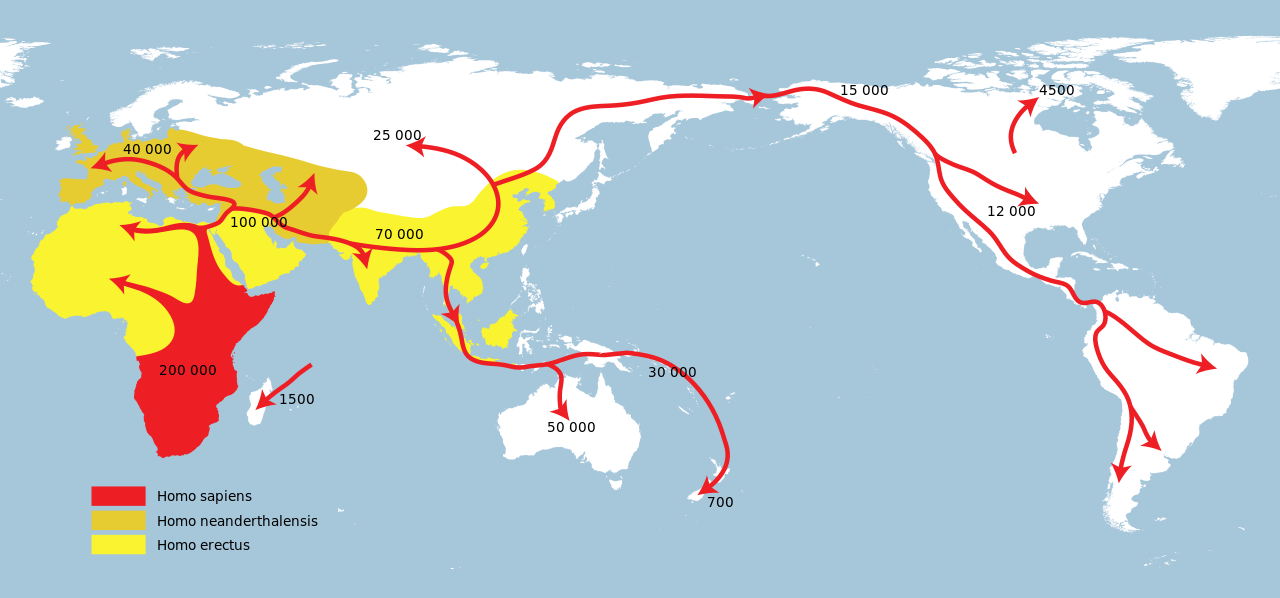 Successive dispersals of Homo ergaster/Homo erectus (yellow), Homo neanderthalensis (ochre) and Homo sapiens (red). Traditionally, H. erectus was seen as the hominin that first left Africa to colonise Europe and Asia. If H. ergaster is distinct from H. erectus, this role would apply to H. ergaster instead.[24][10] Very little concrete information is known on when and which Homo first appeared in Europe and Asia, since Early Pleistocene fossil hominins are scarce on both continents, and that it would have been H. ergaster (or "early H. erectus") that expanded, as well as the particular manner in which they did, remains conjecture.[20] The presence of H. erectus fossils in East Asia means that a human species, most likely H. ergaster, had left Africa before 1 million years ago,[33] the assumption historically having been that they first migrated out of Africa around 1.9 to 1.7 million years ago.[20] Discoveries in Georgia and China push the latest possible date further back, before 2 million years ago, also casting doubt on the idea that H. ergaster was the first hominin to leave Africa.[34] The main reason for leaving Africa is likely to have been an increasing population periodically outgrowing their resource base, with splintering groups moving to establishing themselves in neighboring, empty territories over time. The physiology and improved technology of H. ergaster might have allowed them to travel to and colonise territories that no one had ever occupied before.[33] It is unclear if H. ergaster was truly uniquely capable of expanding outside Africa; australopithecines had likely colonised savannah grasslands throughout Africa by 3 million years ago and there are no clear reasons as to why they would not have been able to expand into the grasslands of Asia before H. ergaster.[19] The general assumption is that hominins migrated out of the continent either across the southern end of the Red Sea or along the Nile Valley, but there are no fossil hominins known from either region in the Early Pleistocene. The earliest Homo fossils outside Africa are the Dmanisi skulls from Georgia (dated to 1.77–1.85 million years old,[34] representing either early H. ergaster or a new taxon, H. georgicus), three incisors from Ubeidiya in Israel (about 1.4 to 1 million years old) and the fossils of Java Man (H. erectus erectus, more than five thousand miles away).[29] The dating of key Asian H. erectus specimens (including Java Man) is not entirely certain, but they are all likely to be 1.5 million years old or younger.[20] Ubeidiya is also the oldest firmly confirmed site of Acheulean tools (one of the tool industries associated with H. ergaster) outside Africa, the tools recovered there closely resembling older tools discovered in East Africa.[33] The earliest fossil evidence of Homo in Asia are the aforementioned Dmanisi skulls, which share many traits with H. ergaster in Africa, suggesting that H. ergaster might have expanded out of Africa as early as 1.7–1.9 million years ago.[35] In addition to H. ergaster-like traits, the Dmanisi skulls possess a wide assortment of other traits, some of which are similar to traits in earlier hominins such as H. habilis, and the site notably lacks preserved hand axes (otherwise characteristic of H. ergaster), which means that hominins might have spread out of Africa even earlier than H. ergaster.[19] The skull D2700 (Dmanisi skull 3) in particular resembles H. habilis in the small volume of its braincase (600 cc), the form of the middle and upper face and the lack of an external nose. The mixture of skulls at Dmanisi suggests that the definition of H. ergaster (or H. erectus) might most appropriately be expanded to contain fossils that would otherwise be assigned to H. habilis or that two separate species of archaic humans left Africa early on.[31] In addition to the Dmanisi fossils, stone tools manufactured by hominins have been discovered on the Loess Plateau in China and dated to 2.12 million years old, meaning that hominins must have left Africa before that time.[34] An alternative hypothesis historically has been that Homo evolved in Asia from earlier ancestors that had migrated there from Africa, and then expanded back into Europe, where it gave rise to H. sapiens. This view was notably held by Eugène Dubois, who first described H. erectus fossils in the 19th century and considered the fossils of Java Man, at the time undeniably the earliest known hominin fossils, as proof of the hypothesis. Though the discovery of australopithecines and earlier Homo in Africa meant that Homo itself did not originate in Asia, the idea that H. erectus (or H. ergaster) in particular did, and then expanded back into Africa, has occasionally resurfaced.[36] Various fossil discoveries have been used to support it through the years, including a massive set of jaws from Indonesia which were perceived to be similar to those of australopithecines and dubbed Meganthropus (now believed to be an unrelated hominid ape). The discovery of H. floresiensis in 2003, which preserved primitive foot and wrist anatomy reminiscent of that of H. habilis and Australopithecus again led to suggestions of pre-erectus hominins in Asia, though there are no known comparable foot or wrist bones from H. erectus which makes comparisons impossible.[37] The idea that H. ergaster/H. erectus first evolved in Asia before expanding back into Africa was substantially weakened by the dating of the DNH 134 skull as approximately 2 million years old, predating all other known H. ergaster/H. erectus fossils.[30] |
進化の歴史 進化と時間的範囲 さらなる情報 人類の進化 § H. エルガスターとH. エレクタス エルガスターの起源は東アフリカにあるとされることが多いが、長い手足、身長、現代的な体のプロポーションなど、それ以前のホモやアウストラロピテクスと は根本的に異なるため、その起源は不明瞭である。東アフリカでは多くの更新世の道具が発見されているが、さらなる化石の発見がない限り、エルガスターが東 アフリカで誕生したとは断定できない[29]。エルガスターの子孫の地理的分布や東アフリカのものと一致する道具から、アフリカ以外の場所にエルガスター の個体群が存在したことが推測されているが、エルガスターの化石は主に東アフリカで発見された180万年から170万年前のものである。ほとんどの化石は ケニアのトゥルカナ湖畔周辺から出土している[10]。 アフリカ最古のH. erectus s.l.(すなわちH. ergaster)の標本として知られているのは、南アフリカのドリモレン・パレオケーブ・システムで発見されたDNH 134の頭蓋骨であり、204万年前から195万年前のものである。この頭骨は、KNM ER 3733との明確な類似性を示す、全体的に最も古いH. erectus s.l.の標本でもあり、初期のH. エルガスターがパラントロプス・ロバストゥスやアウストラロピテクス・セディバなどの他のヒト科動物と共存していたことを示している[30]。 さらに若いエルガスターの標本もあり、特にトゥルカナ・ボーイの年代は約156万年前とされている[10]。 オルドヴァイ峡谷出土の「オルドヴァイ・ホミニッド9」の頭骨は約120万〜110万年前のものであり、ブイア(エリトリアの海岸近く、年代は〜100万 年前)、エチオピアのブーリ層(年代は100万〜78万年前)、ケニアのオロルゲセイリエ(年代は97万〜90万年前)からも断片的な頭骨が見つかってい る。オルドヴァイの頭骨は、その巨大な眉尾根がアジアのH.エレクトゥスに似ているが、他の頭骨はそれ以前のH.エルガスターの頭骨とわずかな違いが見ら れるだけである[31]。 アジアのH.エレクタス、ヨーロッパの後期ホミニン(すなわちH.ハイデルベルゲンシスやH.ネアンデルターレンシス)、アフリカの後期ホミニン(H.サ ピエンス)は、おそらくすべてH.エルガスターの子孫の系統である[10]。H.エルガスターはこれらの後期ホモの祖先であったと考えられているため、脳 のサイズが急速に増大し、H.ハイデルベルゲンシスが出現する約60万年前までアフリカに存続していた可能性がある[32]。 アフリカからの拡大 こちらも参照: ホミニンのアフリカからの初期拡大  ホモ・エルガスター/ホモ・エレクトス(黄色)、ホモ・ネアンデルターレンシス(黄土色)、ホモ・サピエンス(赤色)の相次ぐ拡散。 伝統的に、ホモ・エレクトスはヨーロッパとアジアを植民地化するためにアフリカを最初に出発したホミニンとみなされてきた。H. ergasterがH. erectusと区別されるならば、この役割は代わりにH. ergasterに適用されることになる[24][10]。ヨーロッパとアジアにいつ、どのホモが最初に出現したのかについては、前期更新世の化石ホミニ ンが両大陸で乏しいため、具体的な情報はほとんど知られておらず、拡大したのがH. ergaster(または「初期H. erectus」)であっただろうということや、その具体的な方法については推測のままである[20]。20]。東アジアにおけるエルガスターの化石の存 在は、100万年前よりも前に、おそらくエルガスターであろうヒトの種がアフリカを離れていたことを意味する[33]。 アフリカを離れた主な理由は、増加する人口が定期的にその資源基盤を凌駕し、分裂した集団が時間をかけて近隣の空白の領土に移住して定着したことであった と思われる。H.エルガスターの生理学と改良された技術によって、それまで誰も占領したことのない地域に移動し、植民地化することができたのかもしれない [33]。H.エルガスターが本当にアフリカの外に進出することができるユニークな存在であったのかどうかは不明である。アウストラロピテクスは300万 年前までにアフリカ全土のサバンナの草原を植民地化していた可能性が高く、H.エルガスター以前にアジアの草原に進出することができなかったという明確な 理由はない[19]。 一般的な仮定では、ホミニンは紅海の南端かナイル渓谷に沿って大陸から移動したとされているが、前期更新世にはどちらの地域からもホミニンの化石は確認さ れていない。アフリカ以外で最古のホモの化石は、グルジアのドマニシの頭蓋骨(177万~185万年前のもので、初期のH. ergasterか新しい分類群であるH. georgicusのどちらかを表す[34])、イスラエルのウベイディヤの3本の切歯(約140万~100万年前のもの)、ジャワ人(H. erectus erectus、5,000マイル以上離れている)の化石である[29]。また、ウベイディヤは、アフリカ以外でアシュレウス期の道具(エルガスターに関 連する道具産業のひとつ)の出土が確認された最古の遺跡であり、そこで出土した道具は東アフリカで発見された古い道具に酷似している[33]。 アジアにおけるホモの最古の化石証拠は、前述のドマニシの頭骨であり、これらはアフリカのエルガスターと多くの形質を共有しており、エルガスターが170 万~190万年前にアフリカから進出した可能性を示唆している。特にD2700(ドマニシ頭骨3)は、脳梁の容積が小さいこと(600cc)、中顔面と上 顔面の形、外鼻がないことなどがハビリスに似ている[19]。ドマニシでの頭骨の混合は、エルガスター(またはエレクタス)の定義が、ハビリスに分類され る化石を含むように拡張されるか、あるいは2つの別種の古人類が早い時期にアフリカを離れたことを示唆している[31]。ドマニシの化石に加えて、ヒトが 製造した石器が中国の黄土高原で発見され、212万年前のものと年代測定されており、ヒトがそれ以前にアフリカを離れたことを意味している[34]。 歴史的に別の仮説は、ホモはアフリカからアジアに移住した祖先からアジアで進化し、その後ヨーロッパに再び拡大し、そこでサピエンスが誕生したというもの である。この仮説は、19世紀にH.エレクトスの化石を初めて記載したウジェーヌ・デュボア(Eugène Dubois)により提唱されたもので、当時、紛れもなく最古のヒト科の化石として知られていたジャワ人の化石を、この仮説の証拠とみなした。アフリカで アウストラロピテクスとそれ以前のホモが発見されたことは、ホモそのものがアジアで誕生しなかったことを意味するが、特にH.エレクタス(またはH.エル ガスター)がアジアで誕生し、その後再びアフリカに進出したという考えは時折再浮上している。 [インドネシアで発見された巨大な顎はアウストラロピテクスに似ているとされ、メガントロプスと呼ばれた(現在は無関係なヒト科の類人猿であると考えられ ている)。2003年に発見されたフロレシエンシスは、ハビリスやアウストラロピテクスを彷彿とさせる原始的な足と手首の解剖学的構造を保存していたこと から、再びアジアにエレクタス以前のヒト科動物がいた可能性が指摘されるようになった。H. ergaster/H.erectusが最初にアジアで進化してからアフリカに拡大したという考えは、DNH 134の頭蓋骨の年代測定が約200万年前であり、他のすべての知られているH. ergaster/H.erectusの化石よりも前であったことから、大幅に弱まった[30]。 |
| Anatomy Build and appearance  KNM-WT 15000 ("Turkana Boy"), a 7 to 12 year old Homo ergaster The only well-preserved post-cranial remains of H. ergaster come from the Turkana Boy fossil. Unlike the australopithecines, Turkana Boy's arms were not longer relative to their legs than the arms of living people and the cone-shaped torso of their ancestors had evolved into a more barrel-shaped chest over narrow hips, another similarity to modern humans.[38] The tibia (shin bone) of Turkana Boy is relatively longer than the same bone in modern humans, potentially meaning that there was more bend in the knee when walking.[39] The slim and long build of Turkana Boy may be explained by H. ergaster living in hot and arid, seasonal environments. Through thinning of the body, body volume decreases faster than skin area and greater skin area means more effective heat dissipation.[40] H. ergaster individuals were significantly taller than their ancestors. Whereas Lucy, a famous Australopithecus fossil, would only have been about 1 m (3 ft 3 in) tall at her death, Turkana Boy was about 1.62 m (5 ft 4 in) tall and would probably have reached 1.82 m (6 ft) or more if he had survived to adulthood.[38] Adult H. ergaster are believed to have ranged in size from about 1.45 to 1.85 m (4 ft 9 in to 6 ft 1 in) tall.[39] Because of being adapted to a hot and arid climate, H. ergaster might also have been the earliest human species to have nearly hairless and naked skin. If instead H. ergaster had an ape-like covering of body hair, sweating (the primary means through which modern humans prevent their brains and bodies from overheating) would not have been as efficient.[40] Though sweating is the generally accepted explanation for hairlessness, other proposed explanations include a reduction of parasite load[41] and sexual selection.[42] It is doubtful if australopithecines and earlier Homo were sufficiently mobile to make hair loss an advantageous trait, whereas H. ergaster was clearly adapted for long-distance travel and noted for inhabiting lower altitudes (and open, hot savannah environments) than their ancestors. Australopithecines typically inhabited colder and higher altitudes 1,000–1,600 m (3,300–5,200 ft), where nighttime temperatures would have gotten significantly colder and insulating body hair may have been required.[43] Alternatively and despite this, the loss of body hair could have occurred significantly earlier than H. ergaster. Though skin impressions are unknown in any extinct hominin, it is possible that human ancestors were already losing their body hair around 3 million years ago. Human ancestors acquired pubic lice from gorillas about 3 million years ago, and speciation of human from gorilla pubic lice was potentially only possible because human ancestors had lost most of their body hair by this early date.[44] It is also possible that the loss of body hair occurred at a significantly later date. Genetic analysis suggests that high activity in the melanocortin 1 receptor, which produces dark skin, dates back to about 1.2 million years ago. This could indicate the evolution of hairlessness around this time, as a lack of body hair would have left the skin exposed to harmful UV radiation.[45] Skull and face  KNM ER 3733, a famous Homo ergaster skull Differences to modern humans would have been readily apparent in the face and skull of H. ergaster. Turkana Boy's brain was almost fully grown at the time of his death, but its volume (at 880 cc) was only about 130 cc greater than the maximum found in H. habilis, about 500 cc below the average of modern humans. The 130 cc increase from H. habilis becomes much less significant than what could be presumed when the larger body size of Turkana Boy and H. ergaster is considered.[46] With all H. ergaster skulls considered, the brain volume of the species mostly varied between 600 and 910 cc, with some small examples only having a volume of 508–580 cc. Since their brain was smaller than that of modern humans, the skull of H. ergaster immediately narrowed behind the eye sockets (post-orbital constriction).[39] 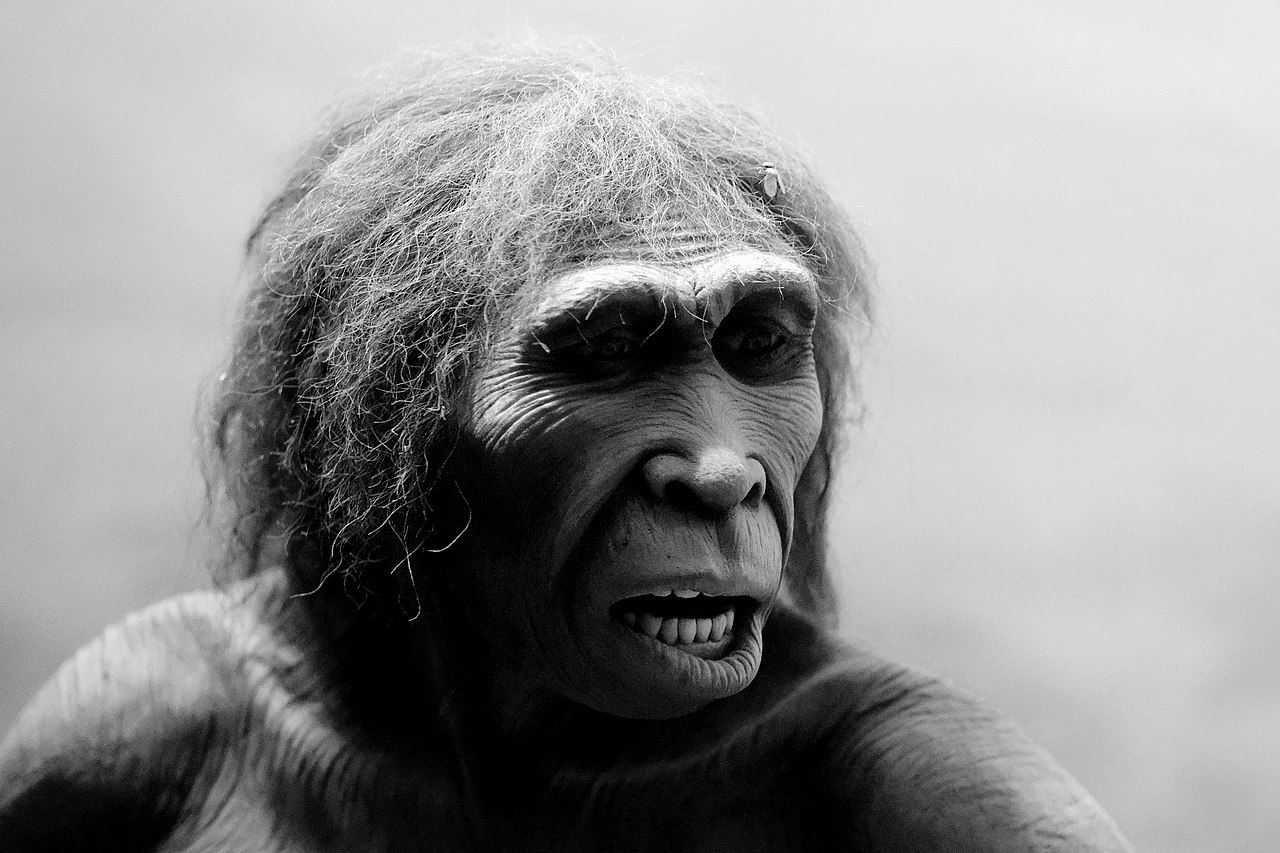 Homo ergaster reconstruction, American Museum of Natural History. The brain case was long and low, and Turkana Boy's forehead was flat and receding, merging at an angle with the brow ridge above their eyes. A noticeable difference between Turkana Boy and the australopithecines and H. habilis would have been their nose, which would have been similar to that of modern humans in projecting forwards and having nostrils oriented downwards. This external nose may have also been an adaptation towards a warmer climate, since the noses of modern humans are usually cooler than their central bodies, condensing moisture that would otherwise have been exhaled and lost during periods of increased activity.[46] The face of Turkana Boy would have been longer from top to bottom than that of modern humans, with the jaws projecting farther outwards (prognathism). Though the jaws and teeth were smaller than those of the average australopithecine and H. habilis, they were still significantly larger than those of modern humans. Since the jaw slanted sharply backwards, it is probable that they were chinless.[40] The overall structure of Turkana Boy's skull and face is also reflected in other H. ergaster skulls, which combine large and outwardly projecting faces with brow ridges, receding foreheads, large teeth and projecting nasal bones.[40] Though Turkana Boy would have been no more than 12 years old when he died, their stature is more similar to that of a modern 15-year-old and the brain is comparable to that of a modern 1-year-old. By modern standards, H. ergaster would thus have been cognitively limited, though the invention of new tools prove that they were more intelligent than their predecessors.[47] Body mass and sexual dimorphism  Reconstruction of Turkana boy by Adrie and Alfons Kennis at the Neanderthal Museum H. ergaster possessed a significantly larger body mass in comparison to earlier hominins such as early Homo, Australopithecus and Paranthropus.[16] Whereas australopithecines typically ranged in weight from 29–48 kg (64–106 lbs), H. ergaster typically ranged in weight from 52–63 kg (115–139 lbs).[48] It is possible that the increased body size was the result of life in an open savannah environment, where increased size gives the ability to exploit broader diets in larger foraging areas, increases mobility and also gives the ability to hunt larger prey.[16] The increased body mass also means that parents would have been able to carry their children to an older age and larger mass.[48] Though reduced sexual dimorphism has often been cited historically as one of the radical differences between H. ergaster and earlier Homo and australopithecines,[16][29] it is unclear whether australopithecines were significantly more sexually diamorphic than H. ergaster or modern humans.[49] Skeletal evidence suggests that sexes in H. ergaster differed no more in size than sexes in modern humans do,[47] but a 2003 study by palaeoanthropologists Philip L. Reno, Richard S. Meindl, Melanie A. McCollum and C. Owen Lovejoy suggested that the same was also true for the significantly earlier Australopithecus afarensis.[49] Sexual dimorphism is difficult to measure in extinct species since the sex of fossils is usually not determinable. Historically, scientists have typically measured differences between the extreme ends (in terms of size and morphology) of the fossil material attributed to a species and assumed that the resulting ratio applies to the mean difference between male and female individuals.[50] Growth and development The dimensions of a 1.8 million years old adult female H. ergaster pelvis from Gona, Ethiopia suggests that H. ergaster would have been capable of birthing children with a maximum prenatal (pre-birth) brain size of 315 cc, about 30–50 % of adult brain size. This value falls intermediately between that of chimpanzees (~40 %) and modern humans (28%).[51] Further conclusions about the growth and development in early Homo can be drawn from the Mojokerto child, a ~1.4–1.5 million year old ~1-year old Asian H. erectus, which had a brain at about 72–84% the size of an adult H. erectus brain, which suggests a brain growth trajectory more similar to that of other great apes than of modern humans.[52] Both the Gona pelvis and the Mojokerto child suggest that the prenatal growth of H. ergaster was similar to that of modern humans but that the postnatal (post-birth) growth and development was intermediate between that of chimpanzees and modern humans.[51] The faster development rate suggests that altriciality (an extended childhood and a long period of dependency on your parents) evolved at a later stage in human evolution, possibly in the last common ancestor of Neanderthals and modern humans.[52] The faster development rate might also indicate that the expected lifespan of H. ergaster and H. erectus was lower than that of later and modern humans.[53] |
解剖学 体格と外見  KNM-WT 15000(「トゥルカナ・ボーイ」)、7〜12歳のホモ・エルガスター 保存状態の良いエルガスターの頭蓋後骨格は、トゥルカナ・ボーイの化石から発見されたものだけである。アウストラロピテクスとは異なり、トゥルカナ・ボー イの腕は現生人類の腕よりも脚に対して長くはなく、彼らの祖先の円錐形の胴体は、狭い腰の上に樽形の胸を持つように進化していた。 [38] トゥルカナ・ボーイの脛骨(すねの骨)は現生人類の同じ骨よりも比較的長く、これは歩くときに膝がより曲がっていたことを意味する可能性がある[39] 。身体を薄くすることによって、身体の体積は皮膚の面積よりも早く減少し、皮膚の面積が大きいということは、より効果的な熱放散を意味する[40]。 エルガスターの個体は祖先よりもかなり背が高かった。アウストラロピテクスの化石として有名なルーシーの身長が死亡時に約1m(3フィート3インチ)で あったのに対し、トゥルカナ・ボーイの身長は約1.62m(5フィート4インチ)であり、おそらく成人まで生存していれば1.82m(6フィート)以上に 達していたであろう[38]。 暑くて乾燥した気候に適応していたため、エルガスターはほぼ無毛で裸の皮膚を持つ最古の人類種であった可能性もある。もしエルガスターが類人猿のような体 毛で覆われていたとしたら、発汗(現代人が脳と体の過熱を防ぐ主な手段)はそれほど効率的ではなかっただろう。発汗は無毛の説明として一般的に受け入れら れているが、他の説明としては寄生虫の負荷の軽減[41]や性淘汰などが提案されている。 [42]アウストラロピテクスやそれ以前のホモが、脱毛を有利な形質とするために十分な移動能力を持っていたかどうかは疑問である。一方、エルガスターは 明らかに長距離移動に適応しており、祖先よりも標高の低い場所(そして開けた暑いサバンナ環境)に生息していたことが知られている。アウストラロピテクス は通常、標高1,000~1,600m(3,300~5,200フィート)の寒冷な高地に生息しており、そこでは夜間の気温が著しく低くなるため、保温性 の高い体毛が必要であった可能性がある[43]。 あるいは、それにもかかわらず、体毛の喪失はエルガスターよりもかなり早く起こった可能性もある。絶滅したヒト科の動物では皮膚の印象は不明であるが、ヒ トの祖先は300万年前にすでに体毛を失っていた可能性がある。ヒトの祖先は約300万年前にゴリラから陰部シラミを獲得しており、ゴリラの陰部シラミか らヒトへの種分化は、ヒトの祖先がこの早い時期までに体毛のほとんどを失っていたからこそ可能であった可能性がある。遺伝子分析によると、黒い皮膚を作り 出すメラノコルチン1受容体の高い活性は、約120万年前までさかのぼることが示唆されている。このことは、体毛がないと皮膚が有害な紫外線にさらされる ことになるため、この頃に無毛が進化したことを示している可能性がある[45]。 頭骨と顔  ホモ・エルガスターの頭蓋骨として有名なKNM ER 3733 ホモ・エルガスターの顔や頭蓋骨には、現生人類との違いがはっきりと表れている。トゥルカナ・ボーイの脳は、死亡時にはほぼ完全に成長していたが、その体 積(880cc)はハビリスに見られる最大値より130ccほど大きく、現生人類の平均値より500ccほど小さかった。ハビリスからの130ccの増加 は、トゥルカナ・ボーイやエルガスターの大きな体格を考慮すると、推定されるものよりもはるかに小さくなる[46]。すべてのエルガスターの頭骨を考慮す ると、この種の脳の容積はほとんどが600ccから910ccの間で変化し、小さな例では508ccから580ccしかないものもあった。彼らの脳は現生 人類よりも小さかったため、エルガスターの頭蓋骨は眼窩の後方ですぐに狭くなった(眼窩後狭窄)[39]。  ホモ・エルガスターの復元、アメリカ自然史博物館。 脳梁は長く低く、トゥルカナ・ボーイの額は平らで後退しており、目の上の眉尾根と斜めに合流している。トゥルカナ・ボーイとアウストラロピテクスやハビリ スとの顕著な違いは、鼻であったろう。鼻は現代人に似て前方に突き出し、鼻孔は下向きであった。現代人の鼻は通常、体の中心部よりも温度が低く、活動が活 発な時期に吐き出され失われるはずの湿気を凝縮するためである[46]。トゥルカナ・ボーイの顔は現代人よりも上から下まで長く、顎はより外側に突き出し ていた(前突症)。顎と歯は平均的なアウストラロピテクスやハビリスよりも小さかったが、それでも現生人類よりもかなり大きかった。顎が後方に大きく傾斜 していたことから、顎がなかった可能性が高い[40]。 トゥルカナ・ボーイの頭蓋骨と顔の全体的な構造は、眉の隆起、後退した額、大きな歯、突き出た鼻骨を持つ、大きく外側に突き出た顔を持つ他のエルガスター 人の頭蓋骨にも反映されている[40]。トゥルカナ・ボーイは死亡時12歳以下であったと思われるが、身長は現代の15歳のそれに近く、脳は現代の1歳の それに匹敵する。現代の基準からすると、エルガスターは認知的に限られていたことになるが、新しい道具の発明は、彼らが先住者よりも知的であったことを証 明している[47]。 体格と性的二型  ネアンデルタール博物館のアドリーとアルフォンス・ケニスによるトゥルカナの少年の復元。 初期ホモ、アウストラロピテクス、パラントロプスなどの初期のホミニンに比べて、エルガスターの体格は著しく大きかった[16]。アウストラロピテクスが 通常29-48kg(64-106ポンド)であったのに対し、エルガスターは通常52-63kg(115-139ポンド)であった。 [48]体格が大きくなったのは、開けたサバンナ環境での生活の結果であった可能性があり、体格が大きくなることで、より広い採食エリアでより広い食餌を 利用することができるようになり、機動性が増し、より大きな獲物を狩ることができるようになる。 性的二型の減少は、エルガスターとそれ以前のホモやアウストラロピテクスとの根本的な違いの一つとして歴史的にしばしば挙げられてきたが[16] [29]、アウストラロピテクスがエルガスターや現生人類よりも著しく性的二型であったかどうかは不明である[49]。しかし、古人類学者のフィリップ・ L・リノ、リチャード・S・マインドル、メラニー・A・マッコラム、C・オーウェン・ラブジョイによる2003年の研究では、同じことがかなり以前のアウ ストラロピテクス・アファレンシスにも当てはまることが示唆されている[49]。通常、化石の性別は確定できないため、絶滅種において性的二型を測定する ことは難しい。歴史的に、科学者たちは通常、ある種に属する化石の(サイズと形態の点で)極端な両端の違いを測定し、その結果の比率がオスとメスの個体の 平均的な違いに当てはまると仮定してきた[50]。 成長と発達 エチオピアのゴナから出土した180万年前のエルガスターの雌成獣の骨盤の大きさから、エルガスターは出生前(出産前)の脳の大きさが最大で315cc、 成獣の脳の大きさの約30~50%の子供を産むことができたと考えられる。この値は、チンパンジー(~40%)と現生人類(28%)の中間の値である [51]。初期ホモの成長と発達についてのさらなる結論は、モジョケルトの子ども(~140万~150万年前の~1歳のアジアのH. モジョケルトの子どもは、成体のH. Erectusの脳の約72-84%の大きさであり、現代人よりも他の類人猿に近い脳の成長軌跡であったことを示唆している[52]。ergasterの 出生前の成長は現生人類と同様であったが、出生後(出産後)の成長と発達はチンパンジーと現生人類の中間であったことが示唆されている[51]。 [51] 発達速度が速いということは、人類進化の後期、おそらくネアンデルタール人と現生人類の最後の共通祖先において、他動性(幼少期が長く、親に依存する期間 が長い)が進化したことを示唆している[52] 。 |
| Culture Diet and energetics  Jaw of Homo ergaster (KNM ER 992 in the top-right, labelled as Homo erectus in the image) compared to jaws of other members of the genus Homo It is frequently assumed that the larger body and brain size of H. ergaster, compared to its ancestors, would have brought with it increased dietary and energy needs.[48] In 2002, palaeoanthropologists Leslie C. Aiello and Jonathan C. K. Wells stated that the average resting metabolic requirements of H. ergaster would have been 39% higher than those of Australopithecus afarensis, 30% higher in males and 54% higher in females.[54] However, the torso proportions of H. ergaster implies a relatively small gut,[54] which means that energy needs might not necessarily have been higher in H. ergaster than in earlier hominins. This is because the earlier ape (and australopithecine) gut was large and energy-expensive since it needed to synthesize fat through fermenting plant matter, whereas H. ergaster likely ate significantly more animal fat than their predecessors. This would have allowed more energy to be diverted to brain growth, increasing brain size while maintaining the energy requirements of earlier species.[55][56] If they had increased energy requirements, H. ergaster would have needed to eat either vastly more food than australopithecines, or would have needed to eat food of superior quality. If they ate the same type of foods as the australopithecines, feeding time would then have had to be dramatically increased in proportion to the extra calories required, reducing the time H. ergaster could use for resting, socialising and travelling. Though this would have been possible, it is considered unlikely, especially since the jaws and teeth of H. ergaster are reduced in size compared to those of the australopithecines, suggesting a shift in diet away from fibrous and difficult-to-chew foods. Regardless of energy needs, the small gut of H. ergaster also suggests a more easily digested diet composed of food of higher quality.[54] It is likely that H. ergaster consumed meat in higher proportions than the earlier australopithecines.[54] Meat was probably acquired through a combination of ambushes, active hunting and confrontational scavenging. H. ergaster must not only have possessed the ability of endurance running, but must also have been able to defend themselves and the carcasses of their prey from the variety of contemporary African predators. It is possible that a drop in African carnivoran species variety around 1.5 million years ago can be ascribed to competition with opportunistic and carnivorous hominins.[57] On its own, meat might not have been able to fully sustain H. ergaster. Modern humans can not sufficiently metabolize protein to meet more than 50% of their energy needs and modern humans who heavily rely on animal-based products in their diet mostly rely on fat to sustain the rest of their energy requirements.[54] Multiple reasons make a fully meat-based diet in H. ergaster unlikely, the most prominent being that African ungulates (the primary prey available) are relatively low in fat and that high meat diets demand increased intake of water, which would have been difficult in an open and hot environment. Modern African hunter-gatherers who rely heavily on meat, such as the Hadza and San peoples, also use cultural means to recover the maximum amount of fat from the carcasses of their prey, a method that would not have been available to H. ergaster.[58] H. ergaster would thus likely have consumed large quantities of meat, vastly more than their ancestors, but would also have had to make use of a variety of other food sources, such as seeds, honey, nuts, invertebrates,[58] nutritious tubers, bulbs and other underground plant storage organs.[40] The relatively small chewing capacity of H. ergaster, in comparison to its larger-jawed ancestors, means that the meat and high quality plant food consumed would likely have required the use of tools to process before eating.[59] Social structure and dynamics 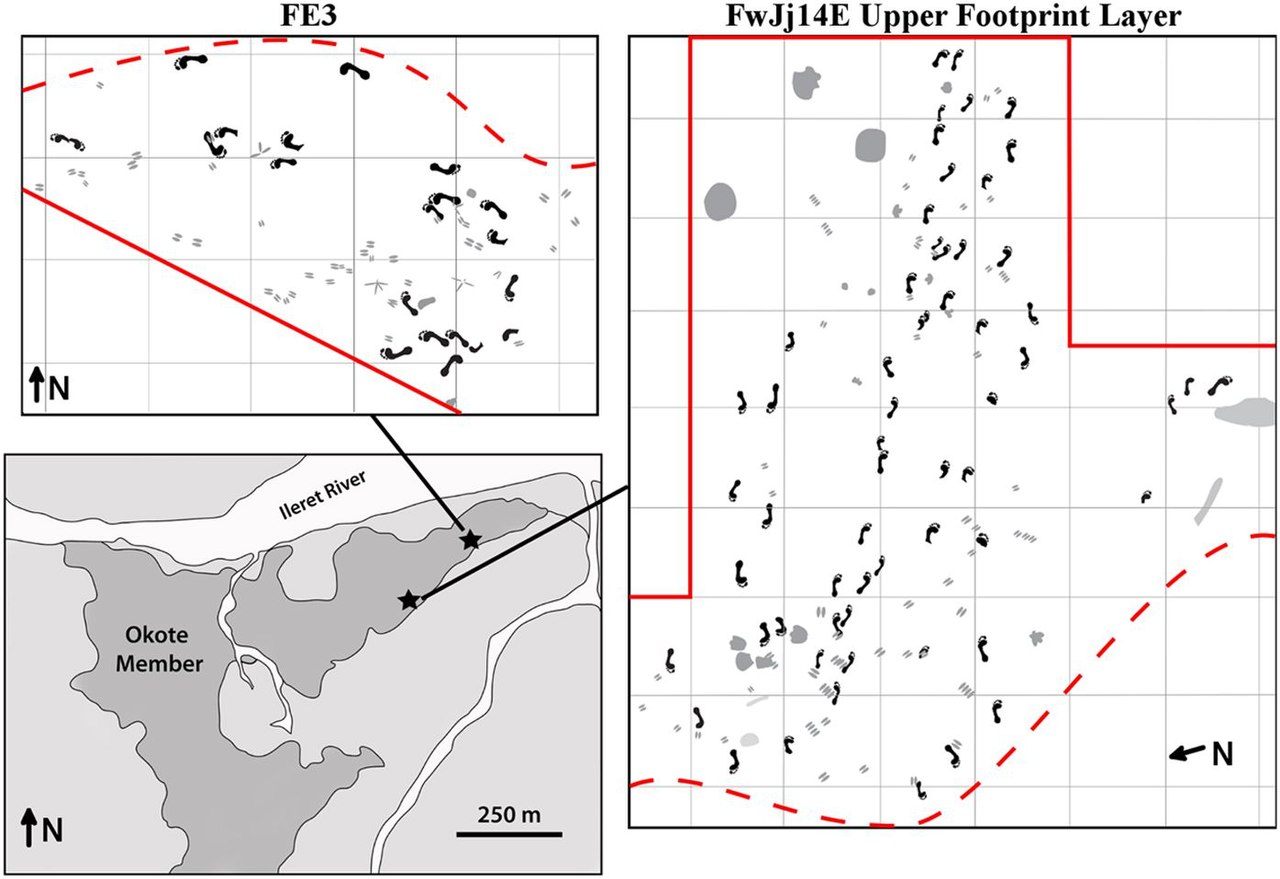 Diagram of fossil trackways from two sites near Ileret, Kenya attributed to Homo ergaster/Homo erectus. H. ergaster lived on the African savannah, which during the Pleistocene was home to a considerably more formidable community of carnivorans than the present savannah. Hominins could probably only have adapted to life on the savannah if effective anti-predator defense behaviours had already evolved. Defense against predators would likely have come through H. ergaster living in large groups, possessing stone (and presumably wooden) tools and effective counter-attack behaviour having been established. In modern primates that spend significant amounts of time on the savannah, such as chimpanzees and savannah baboons, individuals form large, multi-male, groups wherein multiple males can effectively work together to fend off and counter-attack predators, occasionally with the use of stones or sticks, and protect the rest of the group. It is possible that similar behaviour was exhibited in early Homo. Based on the male-bonded systems within bonobos and chimpanzees, and the tendency towards male bonding in modern foragers, groups of early Homo might have been male-bonded as well. Because of the scarcity of fossil material, group size in early Homo cannot be determined with any certainty. Groups were probably large, it is possible groups were above the upper range of known group sizes among chimpanzees and baboons (c. 100 individuals or more).[60] In 1993, palaeoanthropologists Leslie C. Aiello and R. I. M. Dunbar estimated that the group size of H. habilis and H. rudolfensis, based on neocortex size (as there is a known relationship between neocortex size and group size in modern non-human primates),[61] would have ranged from about 70–85 individuals.[62] With the additional factor of bipedalism, which is energetically cheaper than quadrupedalism, the maximum ecologically tolerable group size may have been even larger.[60] Aiello's and Dunbar's group size estimate in regards to H. ergaster was 91–116 individuals.[62] Social and counter-attack behaviour of earlier Homo probably carried over into H. ergaster, where they are likely to have developed even further. H. ergaster was probably the first primate to move into the niche of social carnivore (i. e. hunter-gatherer).[60] Such behaviour would probably have been the result of counter-attacks in the context of competition over nutritious food with other carnivores and would probably have evolved from something akin to the opportunistic hunting sometimes exhibited by chimpanzees. The switch to predation in groups might have triggered a cascade of evolutionary changes which changed the course of human evolution. Cooperative behaviours such as opportunistic hunting in groups, predator defense and confrontational scavenging would have been critical for survival which means that a fundamental transition in psychology gradually transpired. With the typical "competitive cooperation" behaviour exhibited by most primates no longer being favored through natural selection and social tendencies taking its place, hunting, and other activities, would have become true collaborative efforts. Because counter-attack behaviour is typically exhibited in males of modern primates, social hunting in archaic humans is believed to have been a primarily male activity. Females likely conducted other types of foraging, gathering food which did not require hunting (i.e. fruits, nuts, eggs etc.).[63] With hunting being a social activity, individuals probably shared the meat with one another, which would have strengthened the bonds both between the hunters themselves and between the hunters and the rest of the H. ergaster group. Females likely shared what they had foraged with the rest of the group as well. This development could have led to the development of male-female friendships into opportunistic monogamous pair bonds. Since sexual selection from females probably favored males that could hunt, the emerging social behaviour resulting from these new behaviours would have been carried over and amplified through the generations.[63] The only direct evidence of H. ergaster group composition comes from a series of sites outside of Ileret in Kenya, where 97 footprints made around 1.5 million years ago by a group of at least 20 individuals have been preserved. Based on the size of the footprints, one of the trackways appears to have been a group entirely composed of males, possibly a specialised task group, such as a border patrol or a hunting or foraging party. If this assessment is correct, this would further suggest a male-female division of responsibilities. In modern hunter-gatherer societies who target large prey items, male parties are typically dispatched to bring down these high-risk animals, and, due to the low success rate, female parties tend to focus on more predictable foods.[64] Technology Tool production See also: Acheulean  A cordiform hand axe as commonly found in the Acheulean (replica) Early H. ergaster inherited the Oldowan culture of tools from australopithecines and earlier Homo, though quickly learnt to strike much larger stone flakes than their predecessors and contemporaries. By 1.65 million years ago, H. ergaster had created the extensively flaked artefacts and early hand axes that mark the Acheulean culture,[10] and by 1.6–1.4 million years ago, the new tool industry was widely established in East Africa.[65] Acheulean tools differ from Oldowan tools in that the core forms of the tools were clearly deliberate. Whereas the shape of the core forms in Oldowan tools, which were probably used mostly as hammers to crack bones for marrow, appears to not have mattered much, the hand axes of the Acheulean culture demonstrate an intent to produce narrow and sharp objects, typically in teardrop, oval or triangular shapes.[32] Once in place, the Acheulean industry remained unchanged throughout H. ergaster's existence and later times, with tools produced near its end about 250,000 years ago not being significantly different from tools produced 1.65 million years ago.[66] 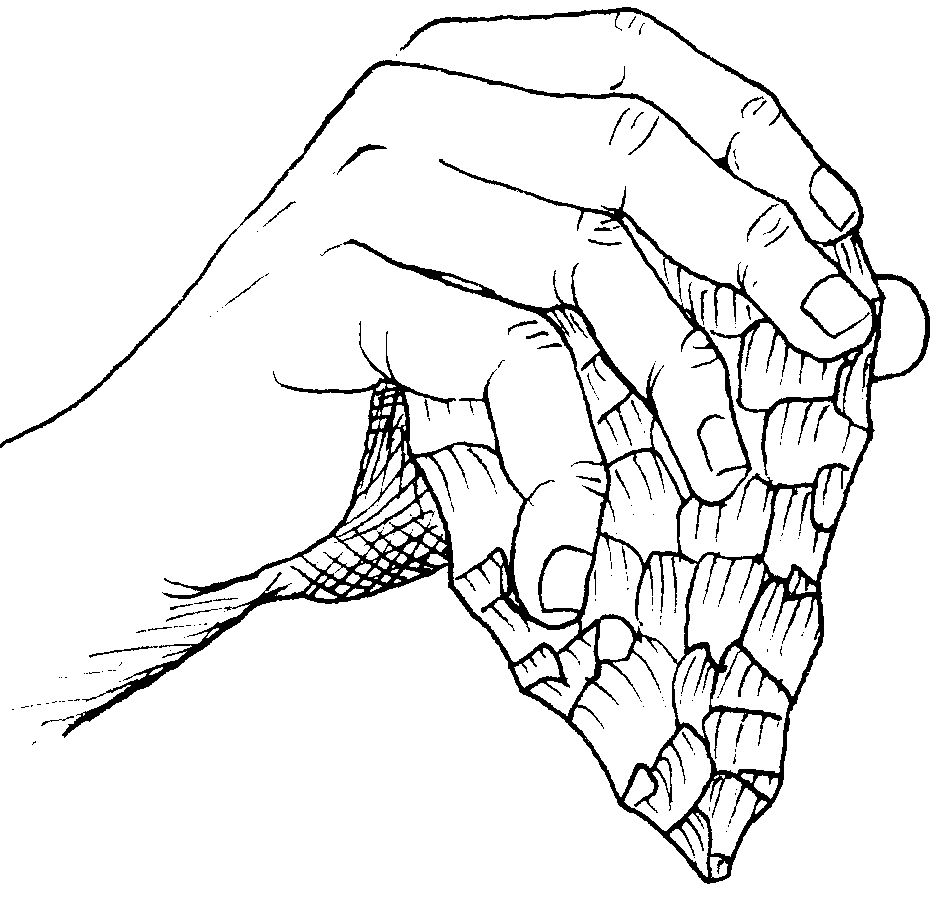 Drawing of a hand holding a hand axe The oldest Acheulean assemblages also preserve core forms similar to those in Oldowan tools, but there are no known true intermediate forms between the two, suggesting that the appearance of Acheulean tools was an abrupt and sudden development. The most significant development that led to the Acheulean tools was likely early hominins learning the ability to strike large flakes, up to 30 cm (1 ft) or more in length, from larger boulders, from which they could manufacture new tools such as hand axes.[65] Though "hand axe" implies that all hand axes were used for chopping and were hand-held, they came in a variety of different shapes and size and probably served several different functions. Carefully shaped and symmetric examples may have been hurled at prey akin to modern discuses, more casually made examples may simply have served as portable sources for sharp flakes and some could have been used for scraping or chopping wood. Additionally, hand axes are effective butchering tools and were possibly also used for dismembering carcasses of large animals.[66] There are preserved hand axes that are too unwieldy and large to be used for any apparent practical purpose. The use of these larger hand axes, and for some discovered collections of hundreds of hand axes without obvious signs of use, is speculative and conjectural. An idea that has been popular in the popular press, and frequently cited in academia,[67] is that large and impressive hand axes might have been emblems used for attracting mates, with makers of large axes showing strength, coordination and determination, qualities that may have been regarded as attractive.[66] Palaeoanthropologists April Nowell and Melanie Lee Chang noted in 2009 that though this theory is "both intriguing and emotionally appealing", there is little evidence for it and it is untestable.[68] They considered it more probable that variations in hand axe morphology over the course of hundreds of thousands of years was the result of various different factors rather than a single, overarching factor in sexual selection.[69] Fire See also: Control of fire by early humans As Homo migrated into open savannah environments, encounters with natural fires must have become more frequent and significant.[70] It is possible that H. ergaster were the earliest humans to master the control of fire, which they may have used for cooking purposes. Cooking renders both meat and plant foods more digestible, which might have been important since the guts of H. ergaster were reduced in size compared to those of their ancestors.[40] Though H. ergaster/H. erectus is frequently assumed to have been the earliest Homo to control fire, concrete evidence is somewhat lacking in the fossil record, perhaps partly due to the difficulty for actual evidence of fire usage to be preserved.[71][72] Two of the earliest sites commonly claimed to preserve evidence of fire usage are FxJj20 at Koobi Fora and GnJi 1/6E near Lake Baringo, both in Kenya and both dated as up to 1.5 million years old. The evidence at FxJj20 consists of burned sediments and heat-altered stone tools, whereas GnJi 1/6E preserves large clasts of baked clay, associated with stone tools and faunal remains. Though it is difficult to exclude a natural origin for the fire residue evidenced, the sites remain strong candidates for early fire use.[73][72] Several sites, preserving more widely accepted evidence of fire usage, have been dated to 1 million years ago or younger, postdating the emergence and last generally accepted record of H. ergaster.[40] These sites include cave sites, such as Wonderwerk and Swartkrans in South Africa, and open sites, such as Kalambo Falls in Zambia. The site Gesher Benot Ya’aqov in Israel, dated to about 700,000 years ago, preserves widely accepted evidence of fire usage through burnt materials and burnt flint microartefacts being preserved at numerous levels.[73][40] From around 400,000 years ago and onwards, traces of fire become even more numerous in sites across Africa, Europe and Asia.[74] Language The spinal cord of Turkana Boy would have been narrower than that of modern humans, which means that the nervous system of H. ergaster, and their respiratory muscles, may not have been developed enough to produce or control speech.[39] In 2001, anthropologists Bruce Latimer and James Ohman concluded that Turkana Boy was afflicted by skeletal dysplasia and scoliosis, and thus would not have been representative of the rest of his species in this respect.[75] In 2006, when anthropologist Marc Meyer and colleagues described a H. erectus s.l. specimen from Dmanisi, Georgia, dated to 1.78 million years old. The fossil preserves the oldest known Homo vertebrae and the spine found falls within the range of modern human spines, suggesting that the individual would have been capable of speech. Meyer and colleagues concluded that speech was probably possible within Homo very early on and that Turkana Boy probably suffered from some congenital defect, possibly spinal stenosis.[76] In 2013 and 2014, anthropologist Regula Schiess and colleagues concluded that there was no evidence of any congenital defects in Turkana Boy, and, in contrast to the 2001 and 2006 studies, considered the specimen to be representative of the species.[77][78] |
文化 食事とエネルギー  ホモ・エルガスターの顎(右上のKNM ER 992、画像ではホモ・エレクトスと表示)と他のホモ属の顎の比較 ホモ・エルガスターは祖先と比較して身体と脳が大きいため、必要な食事量とエネルギー量が増加したと考えられることが多い[48]。エルガスターはアウス トラロピテクス・アファレンシスよりも39%高く、男性で30%、女性で54%高かったと述べている[54]。しかし、エルガスターの胴体のプロポーショ ンは比較的小さな腸を示唆している[54]。というのも、それ以前の類人猿(およびアウストラロピテクス)の腸は、植物性物質を発酵させて脂肪を合成する 必要があったため、大きくエネルギー消費量が多かったのに対し、エルガスターの腸は、それ以前のヒトよりもかなり多くの動物性脂肪を食べていた可能性が高 いからである。そのため、より多くのエネルギーを脳の成長に振り向けることができ、以前の種のエネルギー必要量を維持しながら脳のサイズを大きくすること ができたと考えられる[55][56]。 もしエネルギー要求量が増加していたならば、エルガスターはアウストラロピテクスよりもはるかに多くの食物を食べる必要があったか、あるいはより優れた品 質の食物を食べる必要があったはずである。もし彼らがアウストラロピテクスと同じ種類の食物を食べていたとしたら、余分なカロリーを必要とする分だけ摂食 時間を劇的に増やさなければならず、エルガスターが休息や社交、移動に使える時間が減ってしまう。エルガスターの顎と歯は、アウストラロピテクスと比較し て小さく、繊維質や噛み砕きにくい食物から食事がシフトしたことを示唆している。エネルギーの必要性とは関係なく、エルガスターの小さな腸はまた、より質 の高い食物で構成された、より消化しやすい食事を示唆している[54]。 エルガスターは、それ以前のアウストラロピテクスよりも高い割合で肉を摂取していた可能性が高い。エルガスターは持久的な走力を持っていただけでなく、現 代のアフリカの様々な捕食者から自分自身や獲物の死骸を守ることができたに違いない。150万年前頃にアフリカの肉食動物の種類が減少したのは、日和見的 で肉食のホミニンとの競争に起因する可能性がある[57]。 肉だけではエルガスターを十分に維持できなかったかもしれない。現代人はエネルギー需要の50%以上を満たすためにタンパク質を十分に代謝することができ ず、食事において動物性食品に大きく依存している現代人は、残りのエネルギー必要量を維持するために脂肪に依存していることがほとんどである。ハッザ族や サン族のような食肉に大きく依存する現代のアフリカの狩猟採集民は、獲物の死骸から最大限の脂肪を回収する文化的手段も用いているが、この方法はエルガス ターには利用できなかったであろう[58]。 したがって、エルガスターは祖先よりも大量の肉を消費していた可能性が高いが、種子、蜂蜜、ナッツ、無脊椎動物、[58]栄養価の高い塊茎、球根、その他 の地下植物の貯蔵器官など、他の様々な食料源も利用しなければならなかった可能性が高い[40]。大きな顎を持つ祖先と比較すると、エルガスターの咀嚼能 力は比較的小さいため、消費された肉や高品質の植物性食品は、食べる前に加工するための道具の使用が必要であった可能性が高い[59]。 社会構造と動力学  ホモ・エルガスター/ホモ・エレクトスの祖先とされるケニア、イレレト近郊の2つの遺跡から出土した足跡化石の図。 エルガスターはアフリカのサバンナに住んでいたが、更新世には現在のサバンナよりもかなり手ごわい肉食動物のコミュニティがあった。おそらく、効果的な対 捕食者防衛行動がすでに進化していなければ、ヒト科動物はサバンナでの生活に適応できなかっただろう。捕食者に対する防御は、エルガスターが大きな集団で 生活し、石器(おそらくは木器)を持ち、効果的な反撃行動が確立されていたことによってもたらされた可能性が高い。チンパンジーやサバンナ・ヒヒなど、サ バンナでかなりの時間を過ごす現代の霊長類では、個体が複数の雄からなる大きな集団を形成し、複数の雄が効果的に協力して捕食者を撃退し、時には石や棒を 使って反撃し、残りの集団を守ることができる。同様の行動が初期のホモにも見られた可能性がある。ボノボやチンパンジーの男性結合システムや、現代の採食 者における男性結合の傾向からすると、初期のホモの集団も男性結合だったのかもしれない。化石資料が乏しいため、初期ホモの集団の大きさを確実に決定する ことはできない。おそらく集団は大きく、チンパンジーやヒヒの間で知られている集団の大きさの上限(100個体以上)を超えていた可能性がある[60]。 1993年、古人類学者のレスリーC.アイエロとR.I.M.ダンバーは、新人類に基づいて、ハビリスとH. 現代のヒト以外の霊長類では新皮質の大きさと集団の大きさの間には既知の関係があるため)[61]、新皮質の大きさに基づくと、H. habilisとH. rudolfensisの集団の大きさは約70~85個体[62]であったと推定している。四足歩行よりもエネルギー的に安価な二足歩行という付加的な要 因を考慮すると、生態学的に許容可能な最大集団の大きさはさらに大きかったかもしれない[60]。 それ以前のホモの社会的行動と反撃行動は、おそらくエルガスターにも引き継がれ、そこでさらに発展した可能性が高い。このような行動は、おそらく他の肉食 動物との栄養価の高い食物をめぐる競争の中での反撃の結果であり、おそらくチンパンジーが時折見せる日和見的狩猟に似たものから進化したものであろう。集 団での捕食に切り替わったことで、進化の連鎖が起こり、人類の進化の流れが変わったのかもしれない。集団での日和見的な狩猟、捕食者の防衛、対立的な清掃 といった協力行動は、生存のために不可欠なものであったはずだ。ほとんどの霊長類が示す典型的な「競争的協力」行動は、もはや自然淘汰によって好まれなく なり、社会的傾向がその代わりとなることで、狩猟やその他の活動は真の協力的努力となっただろう。反撃行動は現代の霊長類では一般的にオスに見られるた め、古代の人類における社会的狩猟は主にオスの活動だったと考えられている。女性はおそらく他の種類の採食を行い、狩猟を必要としない食物(果物、木の 実、卵など)を集めていた。 狩猟は社会的な活動であったため、おそらく個体間で肉を共有し、狩猟者自身と狩猟者とエルガスターの他のグループとの絆を強めたであろう。メスも同様に、 採集したものを他のグループと共有していたと思われる。この発展が、オスとメスの友情から、日和見的な一夫一婦制のペアの絆へと発展したのかもしれない。 メスからの性淘汰はおそらく狩りのできるオスに有利であったため、これらの新しい行動から生じた新たな社会的行動は、世代を経て引き継がれ、増幅されたで あろう[63]。 エルガスターの集団構成に関する唯一の直接的な証拠は、ケニアのイレレ郊外にある一連の遺跡から得られている。そこでは、少なくとも20個体からなる集団 が約150万年前に作った97個の足跡が保存されている。足跡の大きさからすると、足跡のひとつは完全に男性で構成された集団であり、おそらく国境警備隊 や狩猟採集隊などの特殊な任務集団であったと思われる。この評価が正しければ、さらに男女の役割分担を示唆することになる。大型の獲物を対象とする現代の 狩猟採集社会では、一般的に男性のパーティーがリスクの高い動物を倒すために派遣され、成功率が低いため、女性のパーティーはより予測可能な食べ物に集中 する傾向がある[64]。 技術 道具の生産 こちらも参照: アシュリアン  アシュレアン期によく見られる紐状の手斧(レプリカ) 初期のエルガスターは、オルドワン文化の道具をアウストラロピテクスやそれ以前のホモから受け継いだ。165万年前までに、エルガスターはアシュレアン文 化を特徴づける広範な薄片状の遺物や初期の手斧を作り出し[10]、160万~140万年前までには、新しい道具産業が東アフリカに広く定着していた [65]。アシュレアン道具がオルドワン道具と異なる点は、道具の芯の形が明らかに意図的であった点である。骨髄を得るために骨を砕くためのハンマーとし て主に使用されたと思われるオルドワンの道具の芯の形状は、あまり重要ではなかったようであるのに対して、アシュレアン文化の手斧は、典型的にはティアド ロップ型、楕円形、または三角形の形状をした、細くて鋭い物体を生産する意図があることを示している[32]。一旦設置されると、アシュレアン産業は、 H. エルガスターの存命中も、その後の時代も変わらず、約25万年前の終わり頃に生産された道具は、165万年前に生産された道具と大きな違いはなかった [66]。  手斧を持つ手の図面 最古のアシュレアン人の集合体には、オルドワン人の道具に見られるような核となる形も残されているが、両者の真の中間的な形は知られておらず、アシュレア ン人の道具の出現は突然のことであったと考えられる。アシュレアン工具につながる最も重要な発展は、おそらく初期のヒトが大きな岩石から長さ30cm以上 の大きな薄片を叩き出す能力を身につけ、そこから手斧のような新しい工具を製造できるようになったことである[65]。「手斧」というと、すべての手斧が 切り刻むのに使われ、手で持っていたように思われるが、手斧にはさまざまな形や大きさがあり、おそらくいくつかの異なる機能を果たしていた。慎重に形作ら れた左右対称のものは、現代の円盤投げのように獲物に投げつけられたかもしれないし、もっと気軽に作られたものは、単に鋭利なフレークの携帯用として使わ れたかもしれないし、木を削ったり切ったりするのに使われたかもしれない。さらに、手斧は効果的な屠殺道具であり、大型動物の死骸を解体するためにも使わ れた可能性がある[66]。 保存されている手斧の中には、明らかに実用的な目的に使用するには扱いにくく、大きすぎるものがある。このような大型の手斧の使用や、明らかに使用された 形跡のない何百本もの手斧のコレクションが発見されたことについては、推測の域を出ない。一般紙で人気があり、学術界でも頻繁に引用されている考え [67]は、大きくて印象的な手斧は、相手を惹きつけるための紋章であったかもしれないというものである。 [66]古人類学者のエイプリル・ノウェルとメラニー・リー・チャンは2009年に、この説は「興味をそそられ、感情的に訴えかける」ものではあるが、そ の証拠はほとんどなく、検証不可能であると指摘している[68]。彼らは、数十万年にわたる手斧の形態の変化は、性淘汰における単一の包括的な要因ではな く、さまざまな異なる要因の結果である可能性が高いと考えた[69]。 火 こちらも参照: 初期人類による火の支配 ホモがサバンナの開けた環境に移動するにつれて、自然の火との遭遇はより頻繁かつ重要なものとなったに違いない。調理は肉や植物性食品をより消化しやすく するが、エルガスター人の内臓は祖先の内臓に比べて小さくなっていたため、このことは重要であったかもしれない[40]。エレクトゥスは火を操る最古のホ モであったと仮定されることが多いが、化石記録には具体的な証拠がやや欠けている。FxJj20の証拠は、焼かれた堆積物と熱で変質した石器で構成されて いるが、GnJi 1/6Eでは、石器や動物遺体とともに焼かれた粘土の大きな塊が保存されている。発見された火気残渣の自然起源を除外することは難しいが、これらの遺跡は 初期の火気使用の有力な候補である[73][72]。 より広く受け入れられている火使用の証拠を保存しているいくつかの遺跡の年代は、エルガスターの出現と一般的に受け入れられている最後の記録より後、 100万年前かそれ以前とされている[40]。約70万年前とされるイスラエルのゲッシャー・ベノー・ヤアコフ遺跡には、多くのレベルで保存されている焼 失物質や焼失した火打石の微小遺物を通じて、火が使用されていたという広く受け入れられている証拠が保存されている[73][40]。 約40万年前以降のアフリカ、ヨーロッパ、アジア全域の遺跡では、火の痕跡がさらに多くなっている[74]。 言語 トゥルカナ・ボーイの脊髄は現生人類よりも狭かったはずであり、エルガスター・ボーイの神経系や呼吸筋は音声を生成したり制御したりするほど発達していな かった可能性がある。 [39]2001年、人類学者のブルース・ラティマーとジェームズ・オーマンは、トゥルカナ・ボーイは骨格形成不全と脊柱側弯症に悩まされていたため、こ の点で他の種を代表するものではなかったと結論づけた[75]。2006年、人類学者のマーク・マイヤーと同僚は、グルジアのドマニシで178万年前に発 見されたH.エレクタスs.l.の標本を発表した。この化石にはホモ最古の脊椎骨が保存されており、発見された脊椎は現生人類の脊椎の範囲内であったこと から、この個体は発話が可能であったことが示唆された。マイヤーと同僚たちは、おそらく発話はホモの中でもかなり早い時期から可能であり、トゥルカナ・ ボーイはおそらく何らかの先天的欠陥、おそらく脊柱管狭窄症に苦しんでいたと結論づけた[76]。 2013年と2014年、人類学者のレギュラ・シースと同僚たちは、トゥルカナ・ボーイには先天的欠陥の証拠はないと結論づけ、2001年と2006年の 研究とは対照的に、この標本は種の代表的なものであると考えた[77][78]。 |
| List of fossil sites List of human evolution fossils |
|
| https://en.wikipedia.org/wiki/Homo_ergaster |
|
リンク
- ロビン・ダンバー『人の進化』 ︎▶︎▶︎︎▶︎▶︎︎▶︎▶︎︎▶︎▶︎︎▶︎▶︎
文献
その他の情報